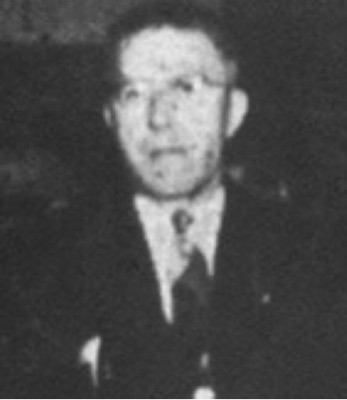
Henry Chavis (Courtesy Ames Historical Society)
Henry William Chavis
Homicide
Henry William Chavis
55 YOA
Highway 69
One mile south of Ames, IA
Story County (jurisdiction)
November 8, 1948
Henry Chavis, 55, lived in a four-bedroom farm house on a 300-acre farm near current-day South Duff Avenue and Airport Road outside Ames, Iowa.
He was found dead outside his home on Nov. 8, 1948.
The following case summary information on Henry Chavis was provided by Luke Jennett, whose article “Mid-Iowa unsolved murders,” appeared in the Ames Tribune on Saturday, June 4, 2011.
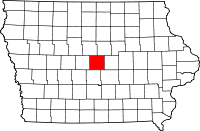 Story County in Iowa
Story County in Iowa
 Ames in Story County
Ames in Story County
On Nov. 8, 1948, Henry Chavis, the owner and operator of Ames Canning Company, was shot to death near the rear door steps of his farm home. His body was found at around 7 a.m. by Nellie Alber, his maid, and “Red” Dinamore, a cab driver who had taken her to the Chavis home.
Physicians estimated Chavis had been dead between three and four hours before he was found.
Press reports say Chavis was shot three times. One wound was positioned in such a way on his arm that it seemed as though he had thrown it up to protect himself from his assailant.
A theory was put forward that the shot to his arm spun him around, allowing a second shot to slam into his back. The third shot was thought to have been fired while Chavis was on the ground, entering through his neck and coming out through his head.
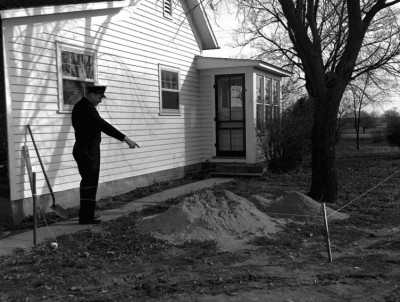 Courtesy Ames Daily Tribune
Courtesy Ames Daily TribuneAmes Police Officer Arlie Schumer points to where he found the bullets outside the Chavis home.
Immediately, investigators began pursuing two main possible motivations, including a robbery or a grudge against Chavis. The robbery motive had possibilities.
Chavis was known to carry large sums of money around, and his wallet was gone when he was found. But investigators pointed publicly to Chavis’ $600 diamond ring, which was still on his finger as proof against it, and questioned why the third shot would have been necessary if all the killer was after was Chavis’ cash.
“One official said that the third bullet was fired by someone who had a ‘vicious mad-on’ for Mr. Chavis,” one of the Tribune news articles of the time noted.
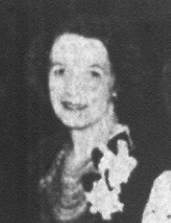 Courtesy Ames Historical Society
Courtesy Ames Historical SocietyGertrude Chavis in 1938
Public suspicion began to fall on Chavis’ wife, Gertrude. She told investigators she had been in Marshalltown that day with two other women for a bowling tournament, but had been at home when her husband was gunned down outside their house. She said she had been asleep and hadn’t heard the shots from her room, which was the furthest point in the house from where the shooting occurred.
Further complicating matters was the fact a handgun owned by Chavis had been reported stolen from their home only a few weeks before the murder, and it was nowhere to be found. The handgun was a .32 caliber, the same as the bullets that killed Chavis.
“Officials admitted that they had checked into reports that Mrs. Chavis had lost a large sum of money gambling in Las Vegas, Nevada, but declined to further comment,” one of the new articles notes suggestively.
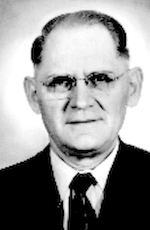 Courtesy Iowa Dept. of Public Safety
Courtesy Iowa Dept. of Public SafetyR.W. “Doc” Nebergall succeeded W.W. Akers as Director of the BCI in 1939 and served as director until 1957.
With Henry Chavis dead, all of his property passed on to Gertrude Chavis. Three weeks after the murder, she offered a $2,500 reward for information on the murder of her husband. But it seemed she wasn’t anxious to keep many reminders of him around, because on Jan. 18, 1949, it was announced she had sold the canning company to a Minnesota group for $100,000. She was the majority stockholder of the company.
The case went nowhere for two years until April 1950 when two 10-year-old children found a rusty handgun embedded in a bank along Squaw Creek. It was determined to be the one reported stolen from the Chavis house, identified by its serial number, and Iowa Bureau of Criminal Investigation Chief R.W. Nebergall said the gun would undergo ballistics tests to determine if it was the weapon that killed Chavis. However, he said, the results of these tests would not be made public.
Representatives with the Iowa DCI said the details of the Chavis case are on microfilm, and they could not comment on where the case sits today.
Copyright © 2011 – Ames Tribune
Information Needed
If you have any information concerning Henry Chavis’ unsolved murder, please contact the Story County Sheriff’s Office at (515) 382-6566, or the Iowa Division of Criminal Investigation at (515) 725-6010 or email dciinfo@dps.state.ia.us.
Sources:



 Ames in Story County
Ames in Story County Courtesy Ames Daily Tribune
Courtesy Ames Daily Tribune Courtesy Ames Historical Society
Courtesy Ames Historical Society Courtesy Iowa Dept. of Public Safety
Courtesy Iowa Dept. of Public Safety
I also think it’s odd that his gun went missing & then he’s shot with the same type of gun just weeks later?
I think it was his wife!
You don’t sell the guys company a couple months after he dies like that.
Plus she has motive because she was addicted to gambling.
I pray justice will be done some day!
I bet the Ames Police Department, is actively investigating the case, so they can’t reveal any evidence. It would hurt the case and maybe cause the suspect to flee. He or she could cross the southern border into Mexico, but then they might be arrested for entering the country illegally.
But, at least his wife got all the money. It helped cover her debts to the boys from Chicago.
Literally, there is not one living soul to prosecute in this case. Any/everyone even remotely connected to it is dead.
Is his wife dead?
I’m curious. At what point in time does it finally get to where they can release information on cases. It’s been 66 years. Odds are the person responsible is dead. I understand that new leads can be found, but not likely after so long.
Is there a time limit before information can be released? 75 years? 100 years after the crime.
Eric, there is no specific time limit for investigating agencies to release information about unsolved/cold cases. It also depends on individual agencies and how they wish to handle the release of any information. Some departments may be willing to release case files to next of kin after 30 or 40 years, while other agencies may refuse to release specific files even 75 years after an unsolved crime. Each situation is unique, and often hinges on whether or not the release of information will compromise what is “still” considered an ongoing investigation, or whether or not it will pose an imminent threat or danger to others.
The vast majority of states don’t have legislation to legally define what a “cold case” is or how much time must pass before the case is considered cold. Arizona (followed closely by Colorado) leads the nation in addressing many of these questions and organizing cold case task forces.
In 2007, the (Arizona) Attorney General’s Cold Case Task Force held several public hearings to discuss cold case issues. The Cold Case Task Force released its final report on Dec. 28, 2007. A recommendation of that report was:
It is recommended that the Arizona Criminal Justice Commission be asked to continue with the Cold Case Task Force efforts and bring together members from the criminal justice community to facilitate the drafting of such legislation and identifying “promising practices.”
As a result, the Arizona legislature passed SB 1274, which states that ACJC shall “Compile and disseminate information on best practices for cold case investigations, including effective victim communication procedures. For the purposes of this paragraph, ‘cold case’ means a homicide or a felony sexual offense that remains unsolved for one year or more after being reported to a law enforcement agency and that has no viable and unexplored investigatory leads.”
The full report is available here.
Another great reference is a document prepared by the National Sheriffs’ Association, Justice Solutions, and the National Organization of Parents of Murdered Children, Inc. It’s available for download in PFD format here.